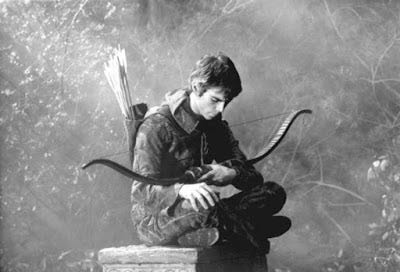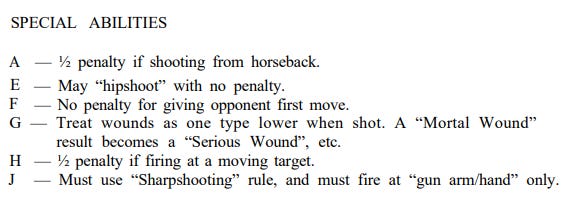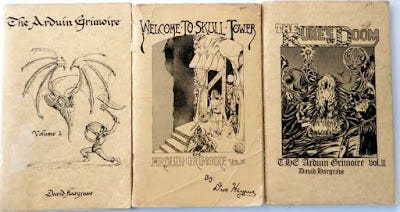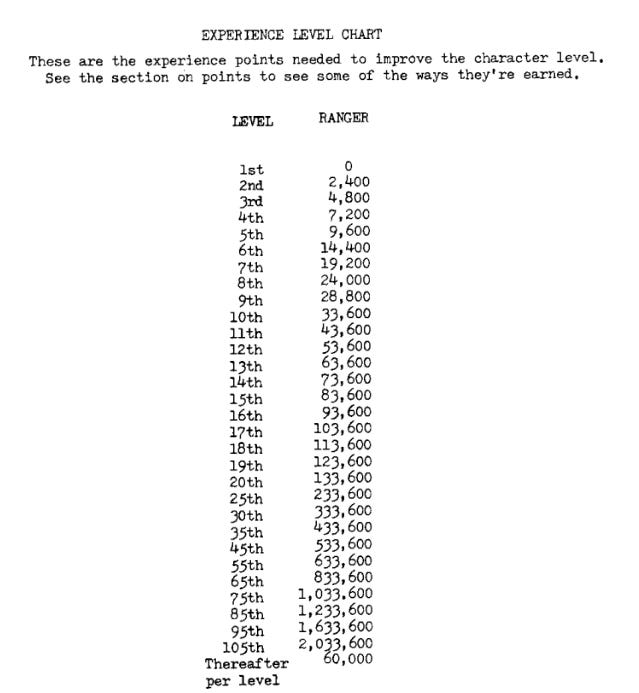D&D Rangers Through the Ages (Part 2): Arduin's Forrester (sic) and the Gaming Scene
This is a discussion of D&D Rangers through the ages and not a discussion of only TSR/WotC/Hasbro Rangers through the ages.

My last post, was the first in a series of posts about the Ranger as a character class in the Dungeons & Dragons role playing game. This discussion was inspired by a tweet by Cam Banks where he shared his concept of what a Ranger character should be. His preferred Rangers are "guerrilla fighters, adept at striking targets quickly and with expertise, operating as scouts and archers and guides" and his argument suggested that the 5th edition D&D Ranger deviated from this central concept to become something more narrow.
In that first post, I wrote about how I thought that the Ranger class has become one of the most "meta" character classes. The current Ranger class includes among its informative archetypes a literary character (Drizzt) who is in turn based on a particular set of choices within earlier editions of the rules.
I know, that's confusing. Let's just say that the class has become self referential. I don't want to retread too much ground from the past article as I move forward, but I do want to provide a little bit of ground work on the origins of the class. As mentioned yesterday, some key examples of the class are Aragorn, Legolas, Tarzan, Jack the Giant Slayer, and Drizzt Do'Urden (the new "iconic" Ranger who has displaced Aragorn in the D&D imagination). There are some others who weren't mentioned, some who were mentioned by T.S. Luikart and Cam in tweets responding to yesterday's post (thanks for reading). In the tweet-versation, Luikart adds Dar the Beastmaster and John Carter to the mix.

Dar is obviously a Ranger along the lines that Cam formulated, though he comes after the 1975 creation of the Ranger class, and John Carter is an interesting choice. I wouldn't necessarily have classified him as a Ranger, but after listening to Fiddleback's GM Word of the Week, I think he's a good fit. This isn't because Fiddleback argues that John Carter is a Ranger, rather because he conveys the military and civilian history of the real world Ranger in a way that makes it a perfect fit for Captain Carter of Virginia. I'd like to add a couple more Rangers, who also happen to have Animal Companions, to the mix. The Lone Ranger and Silver are very much in the line of the class as envisioned by Cam, especially in the radio portrayal of the Ranger character. The Phantom, aka The Ghost Who Walks, with his companions Devil and Hero is also a perfect Ranger. Given that Gygax and crew designed Boot Hill, wrote up stats for the Lone Ranger in Strategic Review vol. 2. no. 2, and may have played using the Curtis et al. Western Skirmish rules before that,
I think that Gary's local group might have also had The Lone Ranger in mind for a couple of classes, the Ranger and the Paladin, but that's only speculation. Since they don’t include rules for the Lone Ranger’s Animal Companion (“Silver”), they may not have been thinking of the Lone Ranger as a Ranger after all but he’s one in my book. Whatever the case, all of these examples fit Cam’s broader definition of Ranger and you can probably think of several others that fit as well. If you can think of some other literary characters who fit this mold, please go ahead and post your thoughts in the comments. I'd love to hear from you.
Now onto the good stuff.
A couple of years after TSR released their version of the Ranger in The Strategic Review, David Hargrave included information about a "Ranger" class in The Arduin Grimoire (1977). In the first Arduin volume, a book that Gary Gygax demonstrated his disdain for when he created the Vacuous Grimoire artifact for AD&D, the class has experience point requirements listed and is included on one of the charts for "special abilities" (more on that below).
Gary Gygax may have found the Arduin Grimoire to be vacuous, but it is full of tons of experimental ideas. The kinds of ideas we see in the modern OSR zine scene where independent projects like Ben Milton’s Knave or J.V. West’s Black Pudding zine offer unique looks at how to play D&D style games. Speaking of scenes, Hargrave's Arduin books are a part of what I refer to as the "California RPG Scene." This scene included the Greg Stafford group that published All the World's Monsters (which Hargrave contributed to and volume 2 of which contains the "Perrin Conventions" that would influence how D&D is played), the Alarums and Excursions creators, and The Complete Warlock RPG group. The California RPG scene has been extremely influential in the development of role-playing games as a hobby and it was responsible for the creation of the Thief Class, Runequest, Champions, Supergame, and a host of other exciting rpg innovations.
(If you check out the Supergame link above, the scan of the 1st edition of the game is from my own personal collection...and that one's not an affiliate link.)
It is really remarkable how much output this community put out in the 1970s and I'm eternally grateful for the fact that UC Riverside, where I'm earning my Ph.D., has copies of many of the fanzines this community was producing at the time.
I'm pretty sure that Hargrave had read the 1975 Strategic Review article referenced in the last post by the time he published his Grimoire, but I don't think he had read it before he began designing his own version of the Ranger for his home game. I say this for one specific reason. He renames his Ranger, "The Forrester" (sic), when it is published in vol. 3 of the Grimoire. This suggests to me that he had been playing with a Ranger equivalent before reading the rules and then continued using it afterwards because his Ranger was different from the one published in Strategic Review. Interestingly, if you've listened to the GM Word of the Day podcast linked above, one might argue that the Strategic Review Ranger represents the "military" version of the class, while Hargrave's represents the "civilian" version.
So what does Hargrave's Ranger look like? Well, there are two parts of his emulation of the archetype.

First, he includes Rangers in a group of characters with a "more or less secret nature." This grouping was listed in a collection of tables that included special abilities new characters start with, abilities that helped to make individual characters more distinct from one another. If you read through the Original D&D rulebook Men & Magic, you'll quickly see that the only thing that differentiates one Fighting Man from another in OD&D are the character's statistics, hit points, and equipment selected by the player. Most of the individualization of the character comes from how the player describes the character and given that all weapons did the same amount of damage prior to the Greyhawk Supplement, things could be pretty static.
To address this mechanical sameness of characters, Hargrave created a series of special ability charts and the Ranger is on the chart with other "Secret"-ive classes like, Thieves, Monks, Ninja, Highwaymen, Corsairs, Assassins, Traders, Slavers, etc. As you can see by that list, Hargrave had a lot of optional classes.
Hargrave was a lover of random charts for good and ill, so I’m not going to share the full list because good God. Among the possible special abilities a new Ranger could acquire via the Secretive Class Abilities table were: Natural Locksmith (“work at two levels above normal for this ability”), +3 attacks versus all attacks by oozes and slimes, +2 with rapiers and foils (he had rapiers early), 50% better night vision, bump of direction, Master Herbalist, Natural Linguist, and many more.
Seriously, you should get yourself a copy of the Arduin Trilogy, but be prepared for the 1970s. There are some entries, not listed, that make one shake one's head in disbelief that he thought they were appropriate, but there are over 30 options which meant that characters in Hargrave's game had a little something to set them apart from other characters of the same class. Modern characters have feat selections, archetypes, backgrounds, different skill choices, but back in OD&D that wasn't the case, so this was pretty innovative. You can see by the grouping of Rangers with "Secret" characters, Hargrave is strongly in the "their guerilla warriors" camp.
The second way Hargrave emulated Rangers was by creating his own class called The Forrester (sic). He describes the class this way:
Clearly has similar inspirations as the official class, though the additional information regarding game preserves adds a nice detail about the real world Rangers and how they might have inspired the class too.
Hargrave's Forrester (sic) doesn't have all the abilities of the official one, in fact it isn't readily clear what the combat capabilities and hit points of the class are. Those do become clear later, but they are unique to Arduin's brutal and lethal game system. The main abilities of the Forrester (sic) are progressive bonuses with "non-mechanical" bows, sensing enemies, good hearing, weather sense, the ability to speak with plants and animals, the ability to heal like a first level Druid (at 15th level), and eventually a bonus with "any weapon."
The class eventually ends up with a +2 (total) bonus to non-mechanical bows and whether the bonus to "any weapon" means a bonus to any weapon the character is using at a given moment or whether the player can pick a single weapon with which to have the bonus isn't clear. The lack of clarity is something common in Arduin. Where OD&D had a lot of gaps in the rules, Arduin has lots of uncertainty for how things work. That uncertainty was common in Old School games. A part of me thinks it’s part of their charm, because it allows for each group to be unique in play. Another part of me thinks it shows how undeveloped game design theory was at the time.
As you can see though, Hargrave's Ranger equivalent is a guerrilla fighter and spy, but one with a focus on bow use. Clearly there's more Robin Hood in Hargrave's Ranger than in the OD&D one. There are no bonuses against "Giant type" creatures. The spell casting is much weaker than the OD&D class, though also more in line with Aragorn's stated capabilities in Fellowship.
It's an interesting take that highlights the creative energies of the California scene, while also demonstrating the amateur nature of the hobby at the time. I don't mean amateur here as a pejorative. Merely that a more professional publication would assume that more clarity is needed in the rules. For the amateur, who is part of an active community constantly in conversation with one another via cons and zines, things can be a little looser. They are also looser because the hobby itself was more amateur at the time. Things weren't rigorously playtested. People were too busy playing FOR THE FIRST TIME and exploring possibilities to playtest. The hobby was growing at a logarithmic pace and you can see that in Hargrave's Arduin books. They may be gonzo and vague, but there is a lot of creative energy here. They were MAKING THINGS and more of us should get back to that practice.









